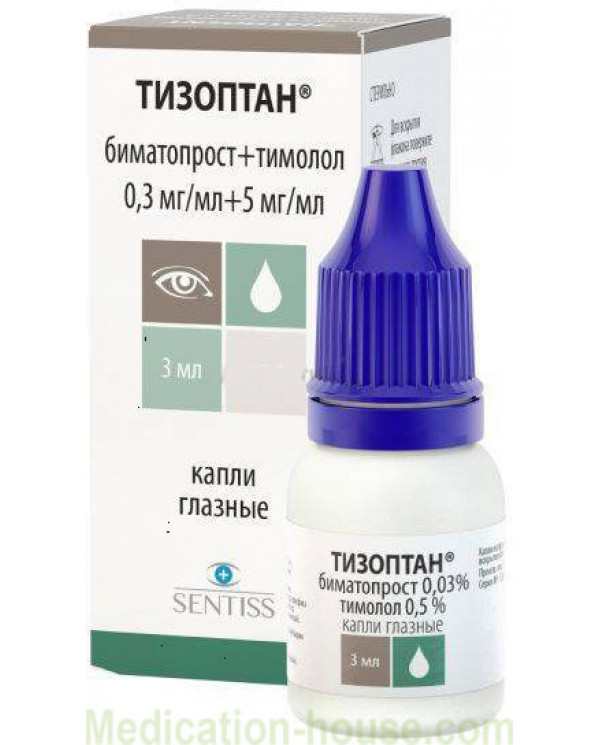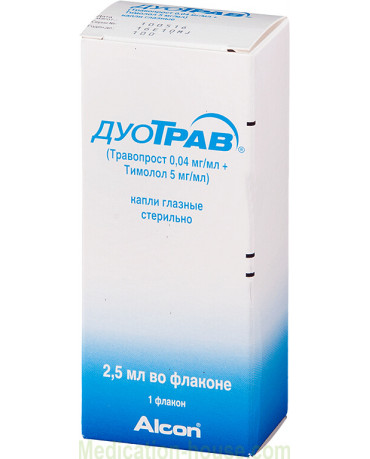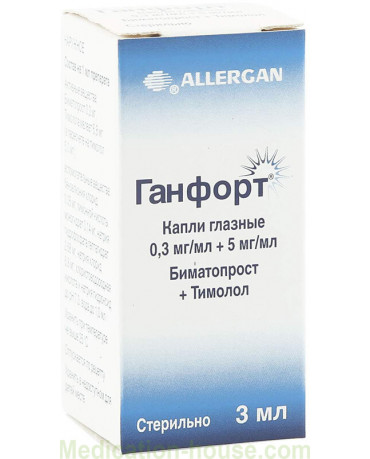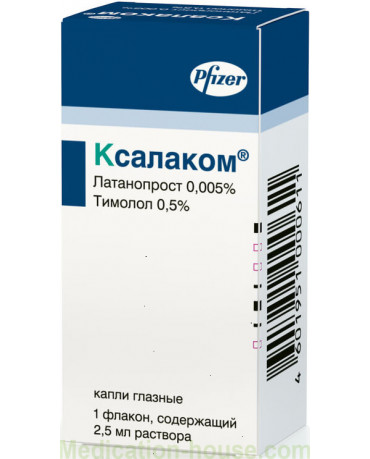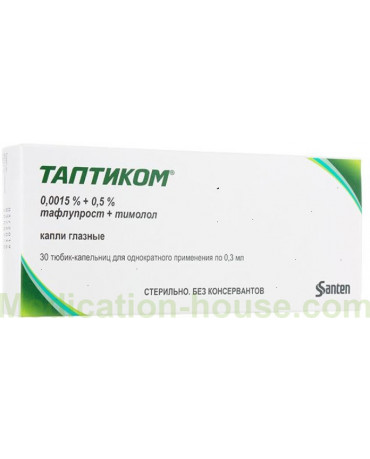Instruction for Tizoptan
Reed more and buy Tizoptan here
Release form and composition
The drug is produced in the form of eye drops: a colorless or slightly yellowish transparent solution (3 ml each in 5 ml white polyethylene bottles, sealed with a blue dropper stopper with a screw cap and first opening control; in a cardboard box 1 or 3 bottles and instructions for the use of Tizoptan).
Composition for 1 ml of the preparation:
active ingredients: bimatoprost - 0.3 mg; timolol - 5 mg (in the form of timolol maleate - 6.83 mg);
auxiliary ingredients: benzalkonium chloride - 0.05 mg; citric acid monohydrate - 0.14 mg; sodium hydrogen phosphate heptahydrate - 2.68 mg; sodium chloride - 6.8 mg; sodium hydroxide - up to pH 7.3; hydrochloric acid - up to pH 7.3; water for injection - up to 1 ml.
Pharmacodynamics
Tizoptan is a complex drug for use in ophthalmology. Its active components, bimatoprost and timolol, significantly reduce IOP (intraocular pressure), due to the combined interaction they provide a more pronounced hypotensive effect in comparison with each of them separately.
Properties of the active ingredients of Tizoptan:
bimatoprost: is a synthetic prostamide, has a chemical structure similar to that of prostaglandin (PG) F2α (PGF2α). It does not affect any of the known types of PG receptors. The hypotensive activity of bimatoprost is based on an increase in the outflow of the intraocular fluid (intraocular fluid) from the eye by the trabecular and uveoscleral pathways;
timolol: a non-selective β-blocker, has no internal membrane stabilizing and sympathomimetic activity. Reduces IOP by reducing the production of IOP. The exact mechanism of action of the substance has not yet been established, it is probably associated with inhibition of the synthesis of cAMP (cyclic adenosine monophosphate) and is caused by endogenous stimulation of β-adrenergic receptors.
Pharmacokinetics
Systemic absorption of the drug is minimal, the degree of absorption of bimatoprost and timolol when used in combination in the composition of the drug does not differ from the degree of absorption when using each of the components separately. During the two studies, lasting 12 months, no systemic accumulation of any of the active substances was observed.
Bimatoprost
In vitro, the penetration of bimatoprost into the sclera and iris of the eye was established. After two weeks of instillation of a 0.03% solution of bimatoprost once a day in both eyes, 1 drop of its Cmax (maximum concentration) in blood plasma was reached 10 minutes after the current dose was instilled, then dropped to 0.025 ng / ml within 1.5 hours (lower limit of definition). The average values of AUC0-24 (areas under the pharmaceutical concentration-time curve for the period from 0 to 24 hours) and Cmax were comparable on days 7 and 14 of instillation and were 0.09 ng × h / ml and 0.08 ng / ml respectively. The results obtained indicate the achievement of an equilibrium concentration of bimatoprost after the first week of its use.
In tissues, bimatoprost is distributed moderately, in a state of equilibrium concentration, the systemic volume of distribution is 0.67 l / kg. It is found mainly in blood plasma. It binds to plasma proteins at a level of ~ 88%. Biotransformation with the formation of various metabolites occurs by oxidation, N-deethylation and glucuronidation.
Bimatoprost is excreted mainly by the kidneys. After intravenous administration of the substance to healthy volunteers was excreted in the urine ~ 67%, through the digestive tract - 25%. T1 / 2 (half-life) after intravenous administration is ~ 45 minutes, total clearance is 1.5 l / h / kg.
When bimatoprost is used in elderly patients twice a day, the average AUC0-24 value reaches 0.0634 ng × h / ml, which is significantly higher than this indicator in healthy young people, which, with the same frequency of use, is 0.0218 ng × h / ml ... Despite this, this difference is not clinically significant due to the low systemic exposure of the substance when it is used topically in both elderly patients and healthy young volunteers. There is no accumulation of bimatoprost in the systemic circulation; the safety profile in elderly patients is identical to that in young people.
Timolol
One hour after instillation of timolol in the form of eye drops in 0.5% patients who received surgical treatment of cataracts, its Cmax in the IHF is 898 ng / ml.
Timolol binds to plasma proteins to an insignificant extent.
A certain amount of the substance enters the systemic circulation, after which it is metabolized in the liver.
T1 / 2 of timolol varies from 4 to 6 hours. Part of the hepatic metabolized substance is excreted through the gastrointestinal tract (gastrointestinal tract), the remainder of the dose and metabolites are eliminated by the kidneys.
Indications for use
Tizoptan is used in the treatment of open-angle glaucoma and intraocular hypertension to reduce IOP in case of insufficient effectiveness of local application of prostaglandin analogs and drugs from the group of β-blockers.
Contraindications
Absolute:
respiratory system: increased reactivity of the airways, including with bronchial asthma in the stage of exacerbation and the presence of information in the history of episodes, advanced stages of COPD (chronic obstructive pulmonary disease);
cardiovascular system: sinus bradycardia, clinically pronounced heart failure, sick sinus syndrome, AV (atrioventricular) block II or III degree without an IVRS (artificial heart pacemaker) implant, sinoauricular block, cardiogenic shock;
period of breastfeeding;
children and adolescents up to 18 years old;
individual hypersensitivity to the components of eye drops.
Tizoptan is recommended to be used with caution in the following conditions / diseases:
impaired hepatic / renal function;
pregnancy;
risk factors for macular edema: aphakia, pseudophakia, intraocular surgery, rupture of the posterior lens capsule, retinal vein occlusion, inflammatory eye diseases, diabetic retinopathy;
intraocular inflammation in the active phase (for example, uveitis), since it may increase;
COPD of mild to moderate severity; the appointment of the drug is allowed provided that the expected benefits of therapy exceed the potential risks;
AV-blockade of the I degree, since the drug can have a negative effect on the time of intracardiac conduction;
corneal disease, since Tizoptan can induce dry eye syndrome;
diabetes mellitus (unstable course), impaired glucose tolerance, since timolol, which is part of eye drops, is able to mask the signs of hypoglycemia;
inflammatory changes in the eyes, angle-closure (neovascular, inflammatory) glaucoma, congenital glaucoma, narrow-angle glaucoma - there is no information on the efficacy and safety of using Tizoptan in patients with these eye pathologies.
Instructions for use: method and dosage
Tizoptan eye drops are intended for topical use by instillation into the conjunctival sac of the eye.
The recommended dosing regimen for the treatment of adult patients, including elderly patients: 1 drop is instilled into the affected eye every day (at the same time: morning or evening).
According to the available literature data, the combination of bimatoprost and timolol is preferably used in the evenings. It is assumed that this time of the instillation procedure is more effective in terms of lowering IOP than instillation in the morning. However, when choosing, one should also take into account the possibility of observing the selected regime.
With a single pass of Tizoptan, the next instillation is carried out at a set time according to the schedule. It is not recommended to exceed the dose, the drug is administered 1 drop into the affected eye 1 time per day. If it is necessary to use two or more solutions, a 5-minute interval between instillations must be observed.
To reduce the side effects and increase the local action of the drug after instillation of the solution, in order to reduce systemic absorption, press the inner corner of the eye with a finger, blocking the lacrimal canal, or close the eyelids for 2 minutes.
Side effects
In the course of clinical studies of Tizoptan eye drops, undesirable side effects were observed, similar to those with the separate use of the active substances of the drug - bimatoprost and timolol. Most often, mild severity of negative reactions from the organ of vision were recorded, none of which was serious. In clinical trials that lasted 12 months, with the highest frequency (~ 26%), conjunctival hyperemia of non-inflammatory etiology, mainly mild, was diagnosed. 1.5% of patients were forced to discontinue therapy due to the development of this side effect.
The frequency of occurrence was determined as follows: very often (≥ 0.1); often (≥ 0.01, but <0.1); infrequently (≥ 0.001, but <0.01); rarely (≥ 0.0001, but <0.001); very rare (<0.0001); with an unknown frequency (according to the available data, it is not possible to determine the frequency of occurrence).
Adverse reactions according to the systemic organ classification, registered with the use of Tizoptan (a combination of bimatoprost and timolol):
immune system: with an unknown frequency - hypersensitivity reactions, including allergic dermatitis, angioedema, eye allergies;
psyche: with an unknown frequency - nightmares, insomnia;
nervous system: often - dizziness, headache; with an unknown frequency - dysgeusia;
organ of vision: very often - hyperemia (redness) of the conjunctiva of the eye; often - corneal erosion, punctate keratitis, burning / itching / tingling in the eyes, photophobia, dry eyes, foreign body sensation, eyelid redness, eye pain, eye discharge; infrequently - conjunctival edema, iridocyclitis, eyelid soreness, trichiasis, asthenopia, iris hyperpigmentation, eyelid retraction, deepening of the eyelid fold; with an unknown frequency - eye edema, cystic macular edema, blurred vision;
heart: with an unknown frequency - bradycardia;
respiratory system: often - rhinitis; infrequently - dyspnea; with an unknown frequency - asthma, bronchospasm (primarily with an existing bronchospastic disease);
skin and subcutaneous fat: often - hirsutism, eyelid skin pigmentation, hyperpigmentation of the periocular region;
general disorders, disorders at the injection site: with an unknown frequency - increased fatigue.
Like other topically applied ophthalmic drugs, the drug (bimatoprost + timolol) is partially absorbed into the systemic circulation. When timolol enters the bloodstream, the development of effects comparable to the systemic action of β-blocking agents is possible. With the instillation of eye drops into the conjunctival sac, the number of undesirable systemic reactions is lower than with systemic use.
Side effects observed with the use of bimatoprost, the development of which is likely during the period of therapy with the drug:
organ of vision: allergic conjunctivitis, blepharospasm, darkened eyelashes, retinal hemorrhage, periorbital erythema, uveitis, blurred vision;
heart: increased blood pressure, Raynaud's syndrome (cold extremities);
Gastrointestinal tract: nausea;
general disorders, disorders at the injection site: asthenia;
data of laboratory and instrumental studies: changes in the activity of liver enzymes.
Side effects observed with the use of timolol, the development of which is likely during the period of therapy with the drug:
organ of vision: retinal hemorrhage, blepharospasm, uveitis;
respiratory system, chest and mediastinal organs: exacerbation of asthma, cough;
Gastrointestinal tract: taste perversion, vomiting, nausea, dyspepsia, diarrhea, dryness of the oral mucosa, abdominal pain;
immune system: systemic hypersensitivity reactions, including Quincke's edema, urticaria, rash, focal / multiple rashes, anaphylaxis;
endocrine system: hypoglycemia;
psyche: insomnia, nightmares, depression, memory loss;
nervous system: acute disturbance of cerebral circulation, syncope, increased symptoms of myasthenia gravis, cerebral ischemia, paresthesia;
heart: bradycardia, edema associated with heart failure, chest pain, heart failure, AV block, congestive heart failure, palpitations, cardiac arrest;
blood vessels: lowering blood pressure;
skin and subcutaneous fat: psoriasis-like rashes or exacerbation of psoriasis, alopecia, skin rash;
musculoskeletal and connective tissue: muscle pain;
genitals and mammary gland: decreased libido, sexual dysfunction;
general disorders, disorders at the injection site: asthenia / fatigue.
Adverse reactions to phosphate-containing eye drops: very rarely - cases of calcification of the cornea in some patients with significant damage to it.
Overdose
With instillation of Tizoptan eye drops, an overdose is unlikely or may be caused by toxic effects.
In case of unintentional ingestion of Tizoptan drops containing a preservative, it is important to consider information on the effect of the active components of the drug:
bimatoprost: in the course of a 2-week experiment on rats and mice, the effect of bimatoprost was studied when taken orally in daily doses up to 100 μg / kg. The dose used in the study, expressed in mg / m2, was 70 times higher than that possible if the entire Tizoptan solution contained in the vial was accidentally ingested by a child weighing 10 kg. At the same time, there were no symptoms of the toxic effect of bimatoprost on experimental animals;
timolol: an overdose may be accompanied by the development of symptoms such as decreased blood pressure, bradycardia, bronchospasm, dizziness, headache, shortness of breath, cardiac arrest. It has been established that timolol is not completely excreted during hemodialysis.
In the case of drug intoxication with the drug, symptomatic and supportive treatment is recommended.
Special instructions
Like other ophthalmic drugs used topically, Tizoptan is able to enter the systemic circulation. Due to the presence of a β-adrenergic component, timolol, in its composition, it is possible for the development of various undesirable effects on the part of systems and organs (including the cardiovascular and respiratory systems), as when using systemic β-blockers. The incidence of such reactions with local application of the drug is lower than with systemic use.
There have been reports of episodes of choroidal detachment due to the use of drugs that reduce the inflow of IHF, such as timolol or acetazolamide, after filtration surgery.
Since ophthalmic preparations containing β-blockers can inhibit the systemic action of β-agonists, for example, epinephrine, it is necessary to inform the anesthesiologist about the use of timolol by the patient before performing surgical anesthesia.
When used together with systemic β-blockers, timolol can enhance their effects or affect IOP. Patients receiving complex treatment are closely monitored. It is not recommended to use two or more local β-blockers simultaneously.
Benzalkonium chloride, which is part of the drug as an excipient, can irritate the mucous membrane of the eye and change the color of soft contact lenses. Therefore, before instillation of eye drops, contact lenses must be removed, they can be put on again 15 minutes after the procedure. In addition, benzalkonium chloride can cause toxic corneal ulcers and / or acute keratitis. In this regard, the condition of a patient who is often or continuously receiving therapy with Tizoptan for dry eye syndrome and corneal changes must be monitored.
The possibility of microbial contamination of the contents of the vial after opening it should not be ruled out, since this can lead to inflammation of the eyes of bacterial etiology. After the first opening, the bottle with eye drops is used no more than 28 days. After the specified time, even if the solution is not completely used, the bottle is disposed of.
The cardiovascular system
In patients with heart failure, the symptoms of the disease must be compensated for before starting therapy with the drug. Patients with severe heart failure are provided with regular monitoring of the condition, including determination of the heart rate.
It is important to take into account that β-blockers can mask the symptoms of hypoglycemia and hyperthyroidism, complicate the course of Prinzmetal's angina pectoris, peripheral and central vascular pathologies, arterial hypotension. For complex peripheral circulatory disorders (severe forms of the disease or Raynaud's syndrome), Tizoptan should be used with caution.
Respiratory system
There were reports that the use of timolol developed side effects from the respiratory system, including with a fatal outcome, due to bronchospasm in patients with bronchial asthma, less often the cause of death was heart failure.
The immune system
Against the background of the use of β-blockers in patients with a history of atopic manifestations and severe anaphylactic reactions to various allergens, standard doses of epinephrine (adrenaline), usually used to stop anaphylactic reactions, may be ineffective.
Hepatobiliary system
When using the drug for the treatment of patients with mild liver diseases, or with initially increased activity of liver enzymes [ALT (alanine aminotransferase), ACT (aspartate aminotransferase)] and / or increased concentration of total bilirubin, during the entire study period lasting more than 2 years, no clinical significant effect of bimatoprost on liver function.
There are no data on the undesirable effect of timolol on liver function.
Organ of vision
Before starting therapy, the doctor must inform the patient about the possible increase in eyelash growth, pigmentation of the eyelid skin and changes in the color of the iris. These side effects were established when studying the pharmacological properties of bimatoprost and the combination of bimatoprost with timolol. Some of the changes may be permanent, so if instillations need to be carried out only in one eye, treatment may be accompanied by the appearance of heterochromia (the patient's eyes will become different colors). After the abolition of Tizoptan, the changed pigmentation of the iris of the eye may remain constant.
After 1 year from the beginning of the use of the drug, eye color change was observed in 0.2% of patients. After the same period of instillation of bimatoprost alone, the iris color changed in 1.5% of patients. There was no further increase in the frequency of this phenomenon with therapy lasting up to 3 years. The change in eye pigmentation is due to increased stimulation of melanin production by the iris melanocytes, and not simply by an increase in the number of melanocytes. The duration of the development of the effect of enhancing the pigmentation of the iris is unknown.
The discoloration of the iris caused by the use of bimatoprost can be mild over a period from several months to several years. Tizoptan does not affect nevi or pigment deposits in the iris. In some patients, pigmentation of the periorbital region is reversible. After the abolition of therapy with miotic drugs in some patients, a change in refraction is possible.
In areas of the skin where the drug accidentally got into, hair growth may increase. Tizoptan must be used strictly in accordance with the instructions, avoiding eye drops on the skin.
Influence on the ability to drive vehicles and complex mechanisms
In case of temporary visual impairment due to the instillation of eye drops Tizoptan, it is required to refrain from driving a car, operating complex machinery, machine tools and production equipment until visual perception is fully restored.
Application during pregnancy and lactation
Adequate data on the use of Tizoptan (bimatoprost + timolol) in women during pregnancy are absent, since strictly controlled studies of the efficacy and safety of this combination have not been conducted during this period. The drug is recommended to be used only if the expected benefit to the mother exceeds the potential risk to the fetus. In animal studies, reproductive toxicity has been established when using high doses of bimatoprost.
According to the results of epidemiological studies, no congenital malformations of the fetus have been identified, but the risk of intrauterine growth retardation has been proven in the case of oral administration of β-blockers. When women used a β-blocker before delivery, the newborns were diagnosed with the following clinical symptoms characteristic of this group of drugs: bradycardia, hypotension, respiratory distress syndrome, hypoglycemia. If it is necessary to use Tizoptan during pregnancy up to the onset of labor in the first days of a newborn's life, specialists are required to monitor his condition. Experiments on animals have shown reproductive toxicity of high doses of timolol, significantly exceeding those used in clinical practice. Therefore, Tizoptan during pregnancy is allowed to be prescribed only in case of urgent need.
Β-blockers are known to pass into human breast milk. But due to the lack of a sufficient concentration of the substance in breast milk, it is unlikely that the use of timolol in therapeutic doses as part of eye drops can lead to the development of clinical symptoms in breastfed children.
There is no information on the penetration of bimatoprost into the breast milk of women, but its presence has been proven in the milk of lactating rats. Tizoptan should not be used while breastfeeding.
Childhood use
The use of Tizoptan in pediatrics is contraindicated.
With impaired renal function
Tizoptan is used with caution in case of renal dysfunction.
For violations of liver function
With caution, Tizoptan eye drops are used for violations of hepatic function.
Use in the elderly
Elderly patients do not need to adjust the dosage regimen of the drug.
Drug interactions
Separate special studies of drug interactions of Tizoptan (combination of bimatoprost + timolol) with other substances / drugs used simultaneously have not been conducted.
The use of ophthalmic solutions containing β-blockers, together with oral administration of BMCC (slow calcium channel blockers), guanethidine, parasympathomimetics, β-blockers, antiarrhythmic drugs (including amiodarone) and cardiac glycosides can cause potentiation of the effects of these drugs with a decrease blood pressure and / or severe bradycardia.
When timolol is used together with CYP2D6 inhibitors (fluoxetine, quinidine, paroxetine), the systemic effect of β-blockers is likely to increase, expressed, for example, by a decrease in heart rate or depression.
Adrenaline (epinephrine), used concomitantly with topical ophthalmic β-blockers, has in some cases contributed to the appearance of mydriasis.
When prescribing Tizoptan with other drugs containing prostaglandin analogs, patients should be provided with medical supervision in order to control changes in IOP.
Very rarely, cases of corneal calcification have been reported with prolonged use of phosphate-containing eye drops in some patients with significant corneal damage.
Terms and conditions of storage
Store in its original packaging at a temperature not exceeding 25 ° C. Keep out of the reach of children.
Shelf life is 2 years.
Drops should be used within 28 days after opening the bottle. To control the duration of the drug use, it is recommended to record the date of opening the bottle on a cardboard box.
Reviews
There are currently no patient reviews about Tizoptan.
Specialists of the FGBNU (Federal State Budgetary Scientific Institution) "Research Institute of Eye Diseases" in a number of works on the study of methods for lowering IOP call a fixed combination of bimatoprost and timolol (including eye drops Tizoptan) the most effective among the known antiglaucoma drugs, since minimum frequency of instillations it has the greatest hypotensive effect.
Terms of sell
You don't need a prescription to buy Tizoptan.

